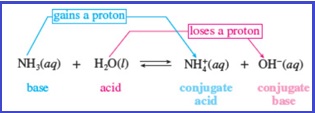
Concept explainers
Identify and label the species in each reaction.
(a)
(b)
(a)
Interpretation:
The species in each of the given reaction has to be identified and labeled.
Concept Information:
When a Bronsted acid donates a proton, what remains of the acid is known as a conjugate base; when a Bronsted base accepts a proton, the newly formed protonated species is known as a conjugate acid. This can be given by the below equation as shown in Figure 1.

Figure 1
The reactant that loses a proton is the acid and the reactant that gains a proton is the base.
Each product is the conjugate of one of the reactant.
Two species that differ only by a proton constitute a conjugate pair
Addition of proton to a species gives its conjugate acid whereas removal of proton from a species gives its conjugate base.
To Label: The equation
Answer to Problem 2PPA
Answer
Explanation of Solution
Hence,
Therefore, the given equation is labeled as,
(b)
Interpretation:
The species in each of the given reaction has to be identified and labeled.
Concept Information:
When a Bronsted acid donates a proton, what remains of the acid is known as a conjugate base; when a Bronsted base accepts a proton, the newly formed protonated species is known as a conjugate acid. This can be given by the below equation as shown in Figure 1.

Figure 1
The reactant that loses a proton is the acid and the reactant that gains a proton is the base.
Each product is the conjugate of one of the reactant.
Two species that differ only by a proton constitute a conjugate pair
Addition of proton to a species gives its conjugate acid whereas removal of proton from a species gives its conjugate base.
To Label: The equation
Answer to Problem 2PPA
Answer
Explanation of Solution
Hence,
Therefore, the given equation is labeled as,
Want to see more full solutions like this?
Chapter 16 Solutions
Chemistry Atoms First, Second Edition
- help draw the moleculearrow_forwardHow to draw this claisen condensation reaction mechanisms/arrow_forwardWrite all of Me Possible Products For each Of the Following reactions. In each case identity all pains of enantiomers, all digsterzoners and all Meso compounds 9. 11-60 11-0-11 V-G Η Η H ~ C-11 +HB+ - 1 H b. पन्ना 171-0-11 H-C-H Н C-C=c-call +HBr Perendez ==arrow_forward
- How can i draw the mechanisms for this molecule?arrow_forwarda. Discuss and explain he difference IN Stability between the Chai and Boat Гольцу от судомехане b. For the Following Molecule draw both possible Clain conformations and explain which one is more stable and for what Reason. H. CH₂ CH₂ H "Harrow_forwarddraw out these molecules pleasearrow_forward
 Chemistry & Chemical ReactivityChemistryISBN:9781337399074Author:John C. Kotz, Paul M. Treichel, John Townsend, David TreichelPublisher:Cengage Learning
Chemistry & Chemical ReactivityChemistryISBN:9781337399074Author:John C. Kotz, Paul M. Treichel, John Townsend, David TreichelPublisher:Cengage Learning Chemistry & Chemical ReactivityChemistryISBN:9781133949640Author:John C. Kotz, Paul M. Treichel, John Townsend, David TreichelPublisher:Cengage Learning
Chemistry & Chemical ReactivityChemistryISBN:9781133949640Author:John C. Kotz, Paul M. Treichel, John Townsend, David TreichelPublisher:Cengage Learning Chemistry: The Molecular ScienceChemistryISBN:9781285199047Author:John W. Moore, Conrad L. StanitskiPublisher:Cengage Learning
Chemistry: The Molecular ScienceChemistryISBN:9781285199047Author:John W. Moore, Conrad L. StanitskiPublisher:Cengage Learning General, Organic, and Biological ChemistryChemistryISBN:9781285853918Author:H. Stephen StokerPublisher:Cengage Learning
General, Organic, and Biological ChemistryChemistryISBN:9781285853918Author:H. Stephen StokerPublisher:Cengage Learning Chemistry: An Atoms First ApproachChemistryISBN:9781305079243Author:Steven S. Zumdahl, Susan A. ZumdahlPublisher:Cengage Learning
Chemistry: An Atoms First ApproachChemistryISBN:9781305079243Author:Steven S. Zumdahl, Susan A. ZumdahlPublisher:Cengage Learning Chemistry: Principles and PracticeChemistryISBN:9780534420123Author:Daniel L. Reger, Scott R. Goode, David W. Ball, Edward MercerPublisher:Cengage Learning
Chemistry: Principles and PracticeChemistryISBN:9780534420123Author:Daniel L. Reger, Scott R. Goode, David W. Ball, Edward MercerPublisher:Cengage Learning





